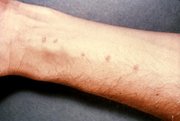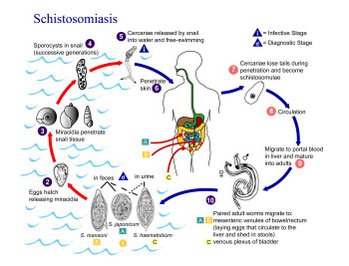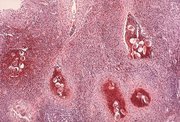Schistosomiasis
Schistosomiasis or bilharzia is a disease affecting many people in developing countries. It is also called snail fever but is not to be confused with swimmer's itch. more...
In certain African communities the process of overcoming Schistosomiasis is an important rite of passage. Although it has a low mortality rate, schistosomiasis can be very debilitating. (Bilharzia, or bilharziosis, is a largely obsolete eponym, after Theodor Bilharz, who first described the cause of urinary schistosomiasis in 1851.)
Types
There are 5 species of flatworms that cause schistosomiasis. Each causes a different clinical presentation of the disease. It should be noted that schistosomiasis may 'metastasize' to different parts of the body irrespective of its particular clinical profile.
- Schistosoma mansoni (ICD-10 B65.1) and Schistosoma intercalatum (B65.8) cause intestinal schistosomiasis
- Schistosoma haematobium (B65.0) causes urinary schistosomiasis
- Schistosoma japonicum (B65.2) and Schistosoma mekongi (B65.8) cause Asian intestinal schistosomiasis
Geographical distribution and epidemiology
The disease is found in tropical countries in Africa, Caribbean, eastern South America, east Asia and in the Middle East. Schistosoma mansoni is found in parts of South America and the Caribbean, Africa, and the Middle East; S. haematobium in Africa and the Middle East; and S. japonicum in the Far East. S. mekongi and S. intercalatum are found focally in Southeast Asia and central West Africa, respectively.
An estimated 200 million people have the disease, 120 million symptomatic. A few countries have eradicated the disease, and many more are working towards it. The World Health Organization is working towards this goal. Controlled urbanization has reduced exposure sites, with a subsequent decrease in new infections. The most common way of getting schistosomiasis in developing countries is by swimming in lakes, ponds and other bodies of water which are infested with the snails (usually of the Biomphalaria or Oncomelania genus) that are the natural reservoirs of the Schistosoma pathogen.
Life cycle
Schistosomes have a typical trematode vertebrate-invertebrate lifecycle, with humans being the definitive host. The life cycles of all five human schistosomes are broadly similar: parasite eggs are released into the environment from infected individuals, rupturing on contact with fresh water to release the free-swimming miracidium. Miracidia infect fresh-water snails by penetrating the snail's foot. After infection, close to the site of penetration, the miracidium transforms into a primary (mother) sporocyst. Germ cells within the primary sporocyst will then begin dividing to produce secondary (daughter) sporocysts, which migrate to the snail's hepatopancreas. Once at the hepatopancreas, germ cells within the secondary sporocyst begin to divide again, this time producing thousands of new parasites, known as cercariae, which are the larvae capable of infecting mammals.
Read more at Wikipedia.org



